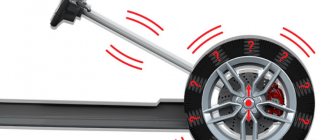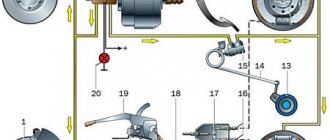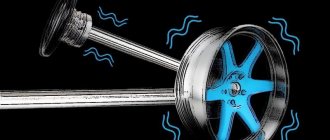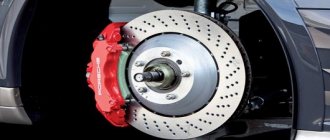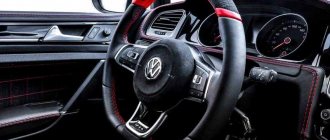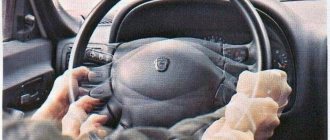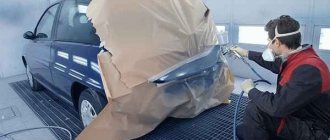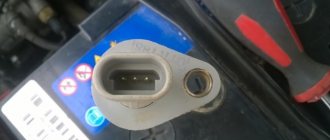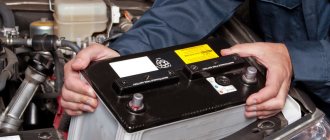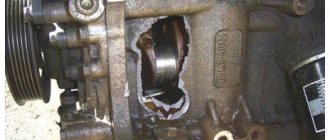The situation was like this. The car was pulled to the left when braking, and very strongly - the steering wheel itself was twisted to the left. It was thrown into the next lane.
When checking the operation of the brakes using emergency braking (on an empty road), smooth operation of the brake mechanisms of 3 wheels was revealed. Naturally, the right front one did not work.
Disassembly showed NO souring of the pistons. But they moved a little slowly. I had already decided to collect it and look elsewhere when, out of curiosity, I checked the front left cylinders. There the pistons moved much easier.
It seems that according to the laws of hydrodynamics at first glance, if the pistons are not soured, then the difference in ease of movement does not affect: the pressure is still the same. But apparently, this difference affects the exit speed of the pistons. And in my case it was like this: the left ones had already grabbed the wheel dead, and the right ones were just crawling up, coping with the friction.
After this conclusion, I performed prophylaxis on the right cylinders. I removed the caliper and rocked them back and forth, removing the rubber boot and lubricating the mirror with brake fluid. The only addition is that when you remove the piston, before pressing it in, you need to turn it with pliers by the non-working edge by 90 degrees. And so on several times. They diverge much faster than just back and forth.
I collected it and went. Everything about everything - 1 hour. And you don’t need a hole, just a cylinder and a head for 17. The main thing is to put a support under the body so that the car doesn’t fall off the jack, and some kind of flat spacer between the pistons when you bring them together, so that it doesn’t squeeze out. If so, then a plate from a worn brake pad will be ideal. I didn't have one and I installed a pry bar and a ratchet wrench.
Now I brake at least halfway - everything is smooth.
I think this procedure can also help in situations where “uneven braking forces on the wheels” are revealed during maintenance.
Why did I write all this? Because I couldn't find a solution on the forum. All the tips for searching for “pulls left/right when braking” boiled down to: 1. change the cylinders 2. change the calipers right away 3. it’s one non-working shock that has this effect 4. change the entire brake system, install 14 discs and calipers from 12, and back discs 5. your car is broken, the geometry is broken, there is no alignment/camber 6. this is an eternal problem with classics/chisels/10s (set by forum name) - it’s impossible to solve
It turns out that sometimes there are significantly simpler solutions. I would be glad if it helps anyone.
What kind of service is this?
If the car pulls to the side when braking, it means the brake on the opposite side has failed: that is, if the car turns to the right, then its left side does not brake and vice versa. Also, the car pulls to the side when the rear wheels brake more actively than the front wheels, and as a result, a skid occurs, which is especially dangerous in winter on slippery roads.
Therefore, at the slightest sensation of the car being pulled to the side during braking, you need to check the serviceability of the brake system: the presence of brake fluid in the system, the tightness of the brake hoses and pipes. All work to check and troubleshoot the brake system must be carried out symmetrically - everything that was done on one side of the car must be done on the other.
The car pulling to the side when braking is associated with the influence of short-term forces on different sides of the car only during braking. These are pronounced signs associated with damage to one of the car systems:
- Brake;
- Chassis;
- Steering.
About the need for regular diagnostics and maintenance
To prevent such malfunctions and work to eliminate them from turning into monthly procedures, it is necessary not to neglect scheduled maintenance and timely diagnostics of the brake system and vehicle suspension. Regularly clean the brake system of dirt.
Diagnostics will allow you to avoid many problems not only in the brake system and suspension. If you periodically inspect your car, you can promptly remove jammed pads, adjust wheel alignment, and equalize tire pressure. And then the car will no longer move to the side, and driving will become much safer and more comfortable.
Keep in mind
If the car pulls to the side when braking, this may turn out to be one of the serious problems with the brakes - air entering the system - and this is an indicator of depressurization and, accordingly, leakage of the fluid itself - as a result, brake failure.
In addition, the causes of such a malfunction may be:
- Wedging of pads and caliper guides;
- Oxidation or lack of sealing of brake cylinders;
- Damage to brake lines and brake hoses;
- Wet surfaces of pads, discs or drums with water or leakage of brake fluid;
- ABS malfunction.
Why does the steering wheel pull to the side?
Spontaneous deviation of the steering wheel from the chosen course to the right or left is dangerous for the driver. In order for the car to continue moving along a given route, additional efforts will have to be made to hold the steering wheel, which will increase the driver's fatigue and reduce his attention to the road situation. At the same time, the reasons why the steering wheel pulls to the left or right are most often quite banal and easily eliminated:
- Tires are incorrectly inflated. In order for a car to move smoothly on the road surface, the tires on one axle must have the same pressure, otherwise a roll to the side is inevitable. If the steering wheel pulls to the left, the left front tire probably has less pressure than the right front tire. Compare the pressure in all wheels; on one axle it should not differ from each other by more than 0.5 atmospheres. It is better to familiarize yourself with the car manufacturer's recommendations on what tire pressure should be maintained;
The above lists defects that the driver can fix on his own or at one of the nearest service centers. In this case, more serious problems are possible - bending of the steering rack, problems with rods, rollers and other elements of the steering mechanism. If none of the tips listed above helped to fix the problem, you need to contact a service center specialized in a particular brand of car to carry out a thorough diagnosis and repair.
Damaged tire
This is already a more significant reason. Tires tend to wear out only partially. Therefore, the stability of the movement of the steered wheels may be lost. It is necessary to carefully check the condition of all tires. If it is not possible to replace damaged rubber, you can turn them over with the smoother side out. This is a way to restore driving stability to the car, and also save on replacing tires. But you need to remember that this can only help for a short time. The tires will still have to be changed.
Steering wheel pulls when accelerating
When spontaneous movement of the steering wheel to the right or left is observed only when accelerating, it is recommended to begin troubleshooting from the following points:
- Checking tire pressure;
- High-quality wheel alignment;
- Inspect the tires for damage or differences in tire wear on one axle.
In rare situations, the steering wheel pulls to the side during acceleration due to serious problems in the steering mechanisms or play.
There are a number of malfunctions that inevitably arise during the operation of any vehicle. A common problem is that the car pulls to the side when driving smoothly in a straight line. The problem manifests itself in different ways: in one case the car pulls strongly to the left (or right), in the second it pulls slightly on a hard road surface, in the third it skids when braking. To eliminate this dangerous phenomenon, it is necessary to find out the reasons for this behavior of the car.
Cause: wear of the ball joint
Ball joints suffer from bad roads on domestic cars no less than the wheels. Any, even barely visible, play when turning the steering wheel is a reason to change the ball joint. And it is advisable to carry out repairs as soon as possible so as not to encounter problems with the steering rack.
Identifying the problem is quite simple. To do this, open the hood and turn the steering wheel all the way to the left. Then from under the right wing the tie rod end, cover and ball mechanism will be clearly visible. Of course, it should not have visible defects. When the steering wheel is turned completely to the right, the left mechanism is also checked.
Afterwards, it is advisable to use the help of another person who rocks the steering wheel from side to side. At this moment, you need to evaluate how accurate the mechanism is, whether there are any backlashes, whether gaps are formed.
How to fix
Only replacing faulty parts with new ones will help completely get rid of the problem.
By the way, after replacing ball or steering racks, you definitely need to check the wheel alignment.
Why does the car deviate from a straight line?
When the car does not want to move straight, the ride becomes uncomfortable - the driver has to constantly steer, and in some situations actually keep the car from drifting. You can’t relax - you’ll end up in a ditch or have a head-on collision with an oncoming car. It is better not to delay in finding out the causes of the described problem.
Spontaneous movement of the machine from a straight path may be a sign of the following problems:
- The pressure in the front tires is very different;
- uneven wear of the front wheel treads;
- faulty steering parts;
- problems with the front suspension and chassis;
- malfunctions of the brake mechanisms.
Before looking for reasons, it is advisable to make sure that the car actually pulls to the side when you let go of the steering wheel. Example: When driving on unpaved and poorly paved roads with ruts, the wheels tend to follow the path of least resistance and are reluctant to leave the grooves. Carry out the test on a flat piece of road surface.
The bulk of the listed problems occur during the acceleration and forward movement of the car. Brake malfunctions are immediately noticeable: the car drifts when slowing down. The more intense the braking, the more the car deviates from the straight line, and the driver has to turn the steering wheel more to keep the vehicle on the desired trajectory.
Uneven tires
The technical regulations attached to the Road Traffic Rules contain direct instructions on the need to use tires with the same tread pattern on all wheels. But many car enthusiasts forget about the existence of this document at the time of obtaining a license, and install wheels on their cars without taking into account their compatibility. And if the left front wheel has a high level of road grip, then most likely the car will confidently pull to the left.
To avoid this problem, use only the same tires, if not on all wheels (preferably on all), then at least on one axle.
Tire problems
The pressure difference in the front wheel cylinders is the most common reason for a car to easily pull away while driving. Diagnosis could not be easier - just measure the pressure with a pressure gauge and, if necessary, pump up the sagging slope. If the car pulls to the right, then low pressure should be observed in the right wheel and vice versa. Otherwise, you need to look for the problem elsewhere.
Equally common is uneven wear of the rubber on the wheels of the front axle. The reasons for the phenomenon are:
- a car enthusiast rarely monitors tire pressure;
- the wheels have not undergone the balancing procedure;
- in front there are tires with different patterns and sizes;
- slopes with a directional pattern are installed incorrectly;
- long driving with unadjusted camber angles of the front wheels.
Rubber of varying degrees of wear often ends up on one axle as a result of seasonal replacement. The owner of the “iron horse” did not mark the removed wheels according to their installation locations and next time he put them on at random. As a result, the rear and front axle tires got mixed up.
Reference. On front-wheel drive cars, the front slopes wear out much faster than the rear ones. If the wheels are mixed up and placed on one axle, the car will begin to pull towards a lower tread.
How to solve the problem of unevenly worn rubber:
- Choose a tire with high tread instead of a worn wheel. For example, install a spare tire.
- Balance the wheels, check and adjust the camber angles. Continuing operation and waiting for the differential to complete its task will increase the load on a tire of a larger diameter, causing the tread to quickly wear out.
- Place the rear slopes forward.
Avoiding the above-described manipulations is quite simple - pump up the cylinders in a timely manner, carry out balancing at intervals of 5 thousand km and visit the camber stand every 10-15 thousand km or after a strong blow to the suspension.
Methods of disabling
A car, and in particular an internal combustion engine, is a balanced, finely tuned mechanism that requires careful operation and care. Sometimes a small mistake made randomly can throw the mechanism out of balance and send it for major repairs or scrap.
However, if we are talking about damage to the installation by adding certain substances to gasoline, we can advise the following:
Use low quality fuel.
First of all, choose gas stations of unknown origin, avoid branded gas stations that supply certified products. When refueling, give preference to gasoline with a low octane number, ideally if the number does not coincide with the number required by your engine (for example, A-76 gasoline instead of AI-95).
Fill up with diesel fuel instead of gasoline.
Gasoline and diesel fuel differ in chemical composition, combustion characteristics, they have different impurities, viscosity, density, combustion temperature, etc. The operating principles of power plants running on diesel and gasoline are also different. If diesel fuel gets into a gasoline engine, it will clog the fuel lines, spoil the engine oil, the engine will simply stall, and it will need to be completely cleaned, washed and repaired.
Aviation kerosene.
Due to stronger detonation during combustion, kerosene will affect the pistons and spark plugs, and as a result will quickly damage these parts.
Additives.
Illiterate use of additives can completely kill your unit. It is better to buy the miracle mixture at the market or gas stations. For example, the well-known octane corrector clogs the fuel supply and increases carbon deposits. Manganese additives have an excellent effect on the catalytic converter. Tetraethyl lead, in large quantities, will definitely break the engine.
White.
Using this type of “fuel” can cause corrosion of power plant parts. According to experts who tested this method, in a short time all the parts will soon become covered with rust. During operation, the engine will smoke heavily and stall frequently. Expensive and complex repairs cannot be avoided.
Drying oil.
When it enters the tank, it dissolves in gasoline. At first, the installation will work as if nothing had happened, but after stopping and trying to start the engine again, a surprise awaits you. Drying oil, having traveled along with gasoline all the way to the cylinders, burns out in the working chamber. After stopping the engine, part of the drying oil settles on the valves and creates a glue effect. As a result, the valves will be bent, the belt will break and major repairs will occur.
Sugar or syrup.
By using this substance, you are guaranteed to clog the pipes, injectors and the entire fuel system as a whole. Troubleshooting will cause a lot of hassle and inconvenience.
Abrasive material.
Sand, polishing paste, carborundum, all of these substances are abrasive materials and will lead to rapid wear of the cylinder-piston group if poured into a car’s gas tank. Of course, the filter will retain some part, but not all.
Water, saline solution, acids, alkalis, solvents.
All these substances, to one degree or another, affect the corrosive properties of gasoline. As a result, increased wear, decreased detonation resistance, increased carbon formation and failure of the installation.
Destroying your power unit is not that difficult. It is not necessary to do this only by influencing it through the fuel, there are many other ways.
An article about what can lead to irreparable damage to a car engine, and how this can be avoided - tips and recommendations. At the end of the article there is a video about how you can kill a car engine.
Sometimes a car owner, without realizing it, makes trivial but critical mistakes that affect the proper operation of the engine and bring its overhaul closer. Therefore, the driver must determine for himself the driving style and manner of handling his iron friend - whether he will operate it to the limit or listen to the manufacturer’s recommendations about careful handling.
Chassis and suspension malfunctions
When mechanical problems occur, the car pulls to the side much more than from the difference in tire pressure or different tread heights. The following faults cause the vehicle to be driven away:
- Worn tie rod ends. The ball pin does not turn well in the hinge, and sometimes it simply jams. A clear sign is that the steering wheel does not return to its original position on its own, the car continues to move in an arc.
- One of the steering rods was bent as a result of the impact and became several millimeters shorter. The toe angle of the front wheels is disrupted, tire wear on the affected side is accelerated, and the car is driven in the appropriate direction.
- The ball joint is stuck. The pin rotates around its own axis with great difficulty and does not allow the wheels to turn freely. At the last stage of wear, the hinge emits a loud creaking sound - a harbinger of final failure.
- The separator of one of the wheel bearings is destroyed. The balls scattered and ground into metal shavings, blocking the rotation of the hub. The car pulls towards the jammed wheel.
- After repairing the suspension, the alignment procedure was performed incorrectly or not done at all.
Power steering and active steering systems: is everything in good condition?
Wedging power steering valves, problems with power steering sensors, problems with the steering rear axle - these malfunctions affect the directional stability of the vehicle. Finding out that the reason really comes from this area is quite simple.
A faulty assistant will be indicated by a barely noticeable turn of the steering wheel in a parking lot with the engine running. To be sure, lift the front axle and start the engine. If the wheels have changed position, then the reason has been found. If not, then the search continues.
Hanging an axle at home is quite problematic. It is much easier to do this with a lift. Or, as an option, visit a specialized station equipped with floor-mounted rotary discs that completely remove the force from the wheels.
Brake problems
Problems with brake mechanisms appear both after pressing the pedal and while driving. The reasons are as follows:
- complete failure of one of the working cylinders, including on the rear axle;
- jamming of the working cylinder piston in various positions;
- fluid leakage from the brake circuit tube;
- failure of the hydraulic valve of the anti-lock braking system.
When the working cylinder on one of the front wheels fails, the car literally rolls away after sharply pressing the brake. If the car pulls to the left, it means the right cylinder is not functioning and vice versa. When the brake cylinder of the rear axle fails, the car does not pull away so clearly. The easiest way to find the “culprit” is by leaking brake fluid, inspecting each hub from an inspection ditch or simply looking under the car.
On cars with high mileage and worn calipers, the piston of the working cylinder may become stuck in the position of squeezing the pads. The wheel on the side of the faulty mechanism is continuously braked, and the car constantly moves in the same direction. It is easy to identify a breakdown: after driving 1–2 km, feel all the wheel rims with your hand. The “culprit” will be revealed by the heated rim.
If the piston of the working cylinder is frozen in a free position, then the vehicle will drift during the braking process - the car will drift in the direction opposite to the non-working mechanism. To finally make sure that the element is broken, hang the wheel from the suspicious side and try to spin it with the brake pedal pressed.
Diagnosing anti-lock braking system (ABS) problems in a garage environment is difficult. If fluid does not pass through one of the valves, you will have to disassemble the calipers and make sure that the cylinders are functioning normally. It’s easier to go to the nearest car service center, where technicians will check the brakes using specialized equipment.
Car pulls when braking – Brake fluid leak
A leaking caliper piston or wheel cylinder will prevent this unit from working properly and will cause improper braking force tension.
Checking the brake caliper
Check the front wheel assemblies by lifting the tires off the ground and securely supporting the vehicle on jack stands. A leaking caliper piston will most likely need a new seal or replacement, but you should also check the piston and cylinder for damage.
Corrosion is usually behind this type of leak. If you haven't changed your brake fluid in more than two years, moisture is likely affecting the sealing surfaces inside the caliper.
It is possible to rebuild the caliper assembly if the cylinder is not too worn or damaged, but it is usually better to simply replace the caliper with a new assembly. If you want to rebuild the caliper, follow the procedure outlined in your vehicle's repair manual. You need to sharpen the cylinder and replace the seal and boot.
Checking the rear wheel cylinder
Checking the rear wheel cylinder is similar to checking the caliper piston for leaks:
- After removing the wheel and drum, check around the cylinder for leaks. If necessary, replace or restore the wheel cylinder.
- If you decide to rebuild the cylinder:
- Make sure the cylinder, pistons, compression spring and expanders are in good condition.
- Sharpen the cylinder and replace the rubber cups.
- Follow the instructions in your vehicle's repair manual.
- Replace the brake fluid in the system.
Check the disc rotors for corrosion and contamination.

